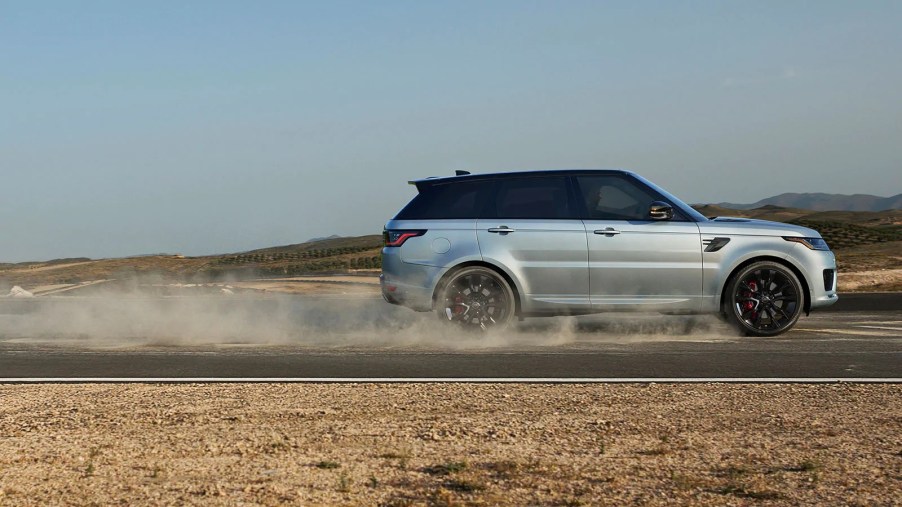
Range Rover Mild Hybrid May Be the Best of the Bunch
Although Range Rovers aren’t the cheapest or most reliable SUVs, they are properly capable off-roaders. Even the cheaper Range Rover Sport, which is more of an on-roader, can genuinely wade through dirt. Though, while Land Rover knows its customers expect off-road competence, the company also knows most Range Rovers stick closely to roads, hence the pavement-focused, high-power SVR. But regardless of trim, the Range Rover offers a luxurious experience. And while the latest Range Rover Sport mild hybrid may have its flaws, it might be the best distillation of the Range Rover ethos.
The Range Rover Sport’s mild hybrid system detailed

In place of the SUV’s 3.0-liter supercharged V6, Roadshow reports, the Range Rover mild hybrid now has a new 3.0-liter super- and turbocharged inline-6. The engine, depending on whether you pick the P360 or P400 configuration, delivers 355 hp and 365 lb-ft or 395 hp and 406 lb-ft, respectively, according to Motor Trend. That power doesn’t come solely from the engine. This is a mild hybrid, similar to the Jeep Wrangler’s system. But the Range Rover’s mild hybrid system is different from the Jeep’s.
Here, although the turbocharger is mechanical, the supercharger is electric. As Car and Driver explains, the supercharger is part of a system that includes a lithium-ion battery, an electric motor-generator, and the 8-speed automatic transmission. At low engine speeds, the motor-generator works with the 48-volt electrical system and supercharger to mask the engine’s turbo lag. The battery drives the motor-generator, which also smooths out the SUV’s start-stop system.

The system isn’t powerful enough to drive the Range Rover on all-electric power, Car and Driver reports. Though there is a plug-in hybrid version, the P400e, that can. Instead, the system is meant to, theoretically, provide more power and improve fuel efficiency. But, while the new Range Rover mild hybrid does have its benefits, fuel efficiency isn’t necessarily one of them.
What’s good about the Range Rover Sport mild hybrid?
Perhaps the best thing about the mild hybrid Range Rover is its smooth and refined powertrain. MT, Car and Driver, and Roadshow all found the start-stop system to be practically vibration- and noise-less. Couple that with the SUV’s high-end interior and comfortable ride, and it makes for a truly serene experience.

The SUV may now weigh almost 5400 pounds, but it can still stop with some authority. MT recorded a 60-0 braking distance of 113 feet, besting both the Mercedes GLE and BMW X5. And while the plug-in hybrid may offer electric-only mode, its system also eats up some storage room.
However, the Range Rover mild hybrid isn’t perfect.
What still needs work?

The EPA estimates the Range Rover mild hybrid can achieve 19 mpg city and 25 mpg city. Together with a 27.6-gallon fuel tank, MT estimated the SUV could go for almost 700 miles on the highway. However, that might be difficult to actually achieve.
Car and Driver recorded 16 mpg during its time with the Range Rover P400 HST, and Roadshow never achieved a better figure than 18 mpg. Part of that may be down to the mild hybrid system’s additional weight. Although, it is worth noting that turbocharged engines often fail to meet their EPA estimates, according to Autotrader. For those wanting max fuel efficiency, the diesel is still the better bet.

And while the inline-6 may be smooth, the transmission can be jerky in stop-and-go traffic. The SUV is also not fast, especially off the line. An SVR this isn’t. And when reviewers did attempt to step off, the turbo unexpectedly kicked in at about 3000 rpm, bringing a rush of acceleration that meant backing off the gas pedal.
Although no reviewer suffered any electrical glitches, the infotainment system received some criticisms. Although well laid-out and easy to navigate, the touchscreens were slow to react to input.
Finally, there comes the question of safety features. While the more-expensive P400 HST does come with a 360-degree camera, lane-departure warning, blind-spot monitoring, and traffic sign recognition, several other features aren’t standard. If buyers want adaptive cruise control or lane-keeping assist, they come as a $4000 Driver Assist package.
Should I buy it?
A base Range Rover Sport P360 SE starts at $68,650; the P400 starts at $82,950. If you want a non-Sport Range Rover mild hybrid, the MSRP to $90,900 and $96,150 respectively. Mercedes’ GLE is somewhat cheaper, starting at just over $61k and topping out at about $80k. Motor Trend also noted BMW’s X5 handles better and is also cheaper.
MT, Car and Driver, and Roadshow did find the Range Rover Sport mild hybrid a little disappointing. Not as quick as its rivals or even the out-going model, not as fuel-efficient as the diesel, and not as sharp as the SVR. But as a luxury SUV, the Range Rover mild hybrid does have a lot to offer. The powertrain is refined, the ride is comfy, and the interior is very well-designed. In balancing refinement and capability, this might the best of the Range Rover lineup.


